Microsoft Surface Pro 3 Review
by Anand Lal Shimpi on June 23, 2014 3:55 AM ESTDisplay Analysis
I published an analysis of Surface Pro 3's display shortly after receiving my review unit. For those of who you haven't seen it already, the results and analysis are reprinted below.
With Surface Pro 3, Microsoft finally accepts that while 16:9 may be a great aspect ratio for watching movies but it's not optimal for a multi-purpose tablet. The tablet features a 12" 2160 x 1440 display (RGB stripe, not RGBW/PenTile), which ends up being a 3:2 aspect ratio. The difference is immediately noticeable in notebook-style use. While the Surface Pro 2 was never quite all that comfortable to use as a laptop, Surface Pro 3's display makes it substantially more laptop-like. There doesn't appear to be a big impact to tablet use either with the larger display. Particularly with Windows 8.1's split screen mode, the larger display ends up working extremely well. The LCD continues to be laminated to the cover glass just like with previous Surfaces.
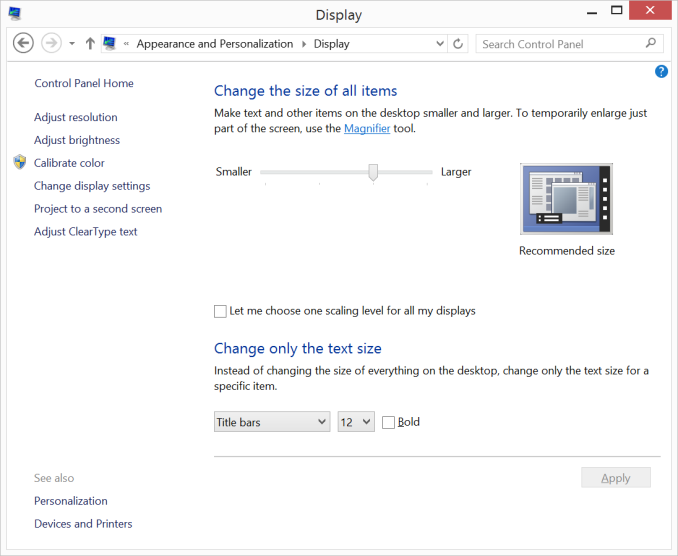
Default 150% Scaling on Surface Pro 3, the 2160 x 1440 display behaves like a HiDPI 1440 x 900 display
Color accuracy is improved out of the box as well. The original Surface Pro had a display capable of being quite accurate, if calibrated, but out of the box it was a bit of a mess. Microsoft slowly improved out of box calibration over the years, eventually culminating in what we have today with Surface Pro 3.

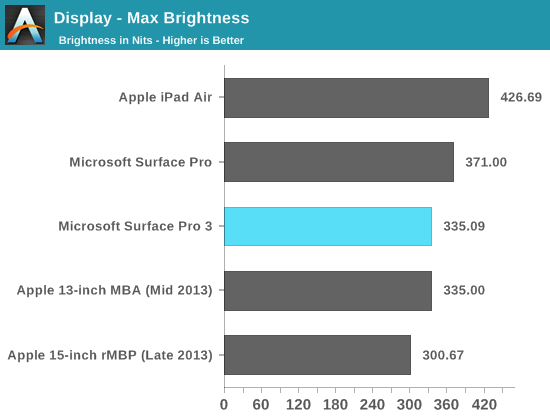
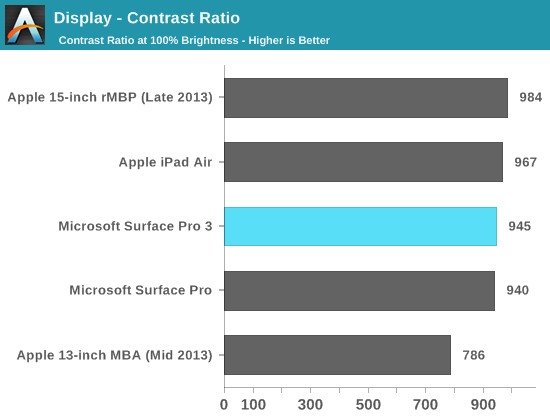
Max brightness drops a bit compared to Surface Pro 2, likely due to the Pro 3 having 50% more pixels to light. Black levels at max brightness are pretty good, thanks in part to Microsoft's optically bonded LCD/cover glass stack. Contrast ratio remains competitive with previous designs.
Grayscale accuracy is the biggest issue with the new display, green levels are just way too high:
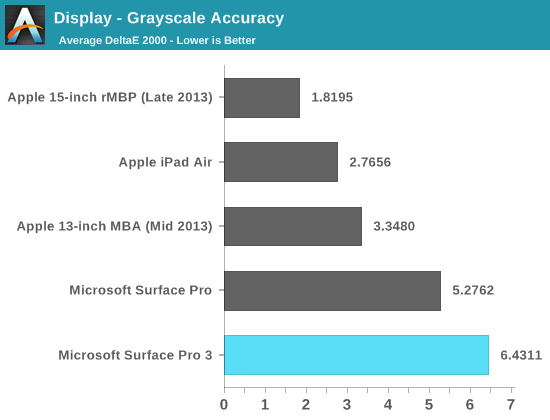
Our basic sRGB gamut test paints a great picture for Surface Pro 3. Full saturation color reproduction is excellent:
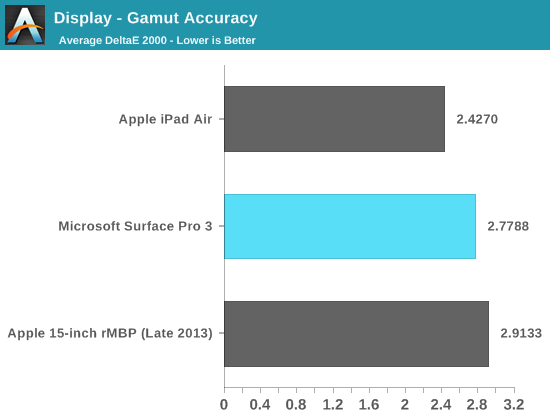
The saturation sweep also looks solid:
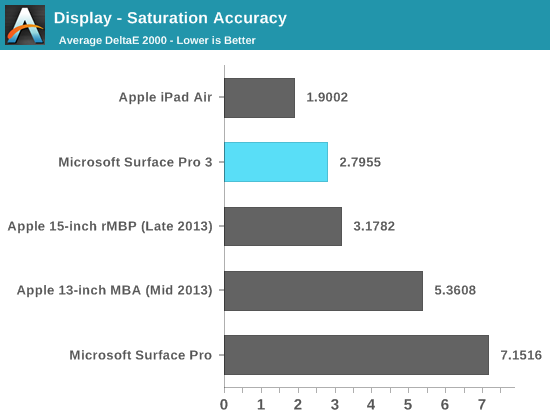
Unfortunately Surface Pro 3 doesn't do so well on our GMB color checker test. Part of the problem is its performance in the grayscale swatches included in this test:

Overall the Surface Pro 3 display is a huge improvement over the previous two generations, but it doesn't quite meet the high standards set by some of the other competitors on the market today from both notebook and tablet spaces.


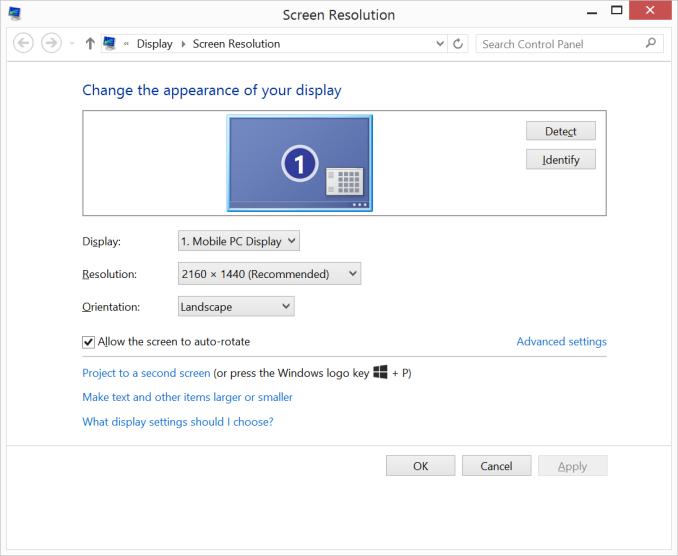



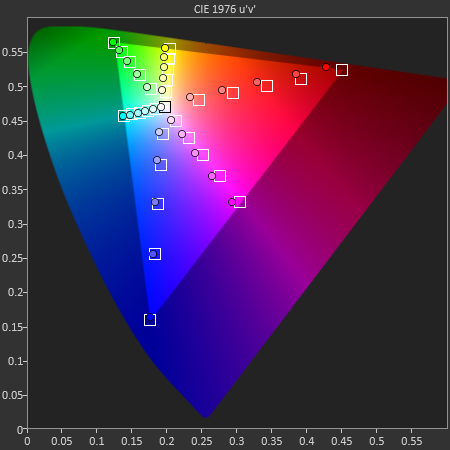










274 Comments
View All Comments
KaarlisK - Monday, June 23, 2014 - link
My one niggle is a lack of build-to-order options.An i3 is enough for me, and a 128GB may be enough for me, but I want 8GB RAM.
joaoasousa - Monday, June 23, 2014 - link
Yep, there's a missing 128 GB / 8 GB combination that would be a sweetspot for a lot of people. I hope MS listens to the feedback and opens up more combinations.DanNeely - Monday, June 23, 2014 - link
No need to open more combinations; just replace the current 4/128 model with an 8/128. Nothing other than a bottom tier windows computer should only have 4gb of ram any longer.tacitust - Tuesday, June 24, 2014 - link
4GB of RAM is nowhere near the same problem for most users when it's paired with an SSD (instead of an HDD).I have an old laptop with 3GB of memory. It was painful to use, because the swap file was so slow and I had to wait several seconds when switching between apps. I was considering upgrading to 4GB and perhaps even 8GB until I dropped in an SSD. Now there is no need, it's already so much faster.
For power users or gamers using memory hungry applications perhaps 8GB would be a good idea, but for the vast majority of users who use a typical mobile workload, paying for the extra 4GB is very likely a waste of money.
andrewaggb - Tuesday, June 24, 2014 - link
Personally I'd rather have 4gb of ram and a 256gb ssd than 8gb of ram and a 128gb ssd.or both... if it didn't drive the price up to $1350 without a cover...
joaoasousa - Tuesday, June 24, 2014 - link
The analysis I saw on the web say that with SSD the 8 GB are only required for gaming (which you can't do anyway) and running VMs. The price jump from 4 GB/128 to 8 / 256 is too much, I'll probably go for the 4/128 one.ccd1 - Monday, June 23, 2014 - link
My biggest reservations at this point is the future. Skylake is likely to be here in 12-15 months. Also, MS has shown a willingness to continually innovate in this space. I anticipate another leap in sophistication for the Pro at that time.skiboysteve - Monday, June 23, 2014 - link
We have said that every iteration. This one looks significant, so if you're in the market... It's a good time to buyccd1 - Monday, June 23, 2014 - link
But if I wait for Skylake, it might be 18-24 months before it is a dinosaur instead of 12! lol!stanwood - Monday, June 23, 2014 - link
This used to be how people felt about Apple products. Big win for MS that they were not scared to put out a pretty good Surface Pro and then iterate quickly.